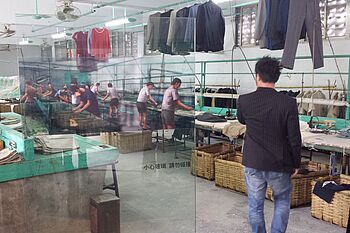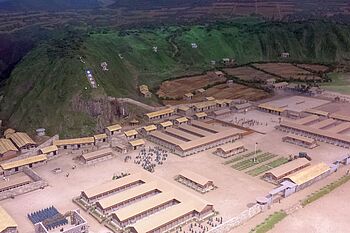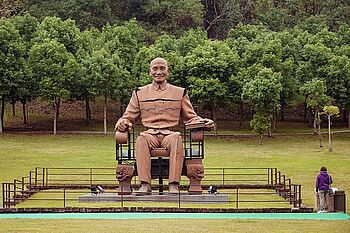The elderly gentleman looks up from his desk in a friendly manner. This is how dictator Chiang Kai-shek continues to be honored in a large memorial hall in Taipei. Coming to terms with the past plays an important role on the island state. For a long time, scholars played little attention to this issue, but in recent years a growing number of studies on the process of transitional justice in Taiwan have been published in English-speaking countries.
Transitional Justice in Taiwan – Change and Challenges

Credit: Hubertus Knabe
The memorial in the former military prison of Taipei has taken great measures to restore the former laundry. Under martial law, prisoners were forced to work here. Since the election victory of the opposition Progress Party in 2016, the process of coming to terms with the past has experienced a noticeable upswing in Taiwan. In 2019 two young Taiwanese scientists compiled a summary of what has been achieved so far and they encourage further research.
The authors Nien-Chung Chang-Liao and Yu-Jie Chen, both members of the Taiwanese Academy of Sciences, examine transitional justice in Taiwan over the past 30 years. In their view, the development of transitional justice suggests that dealing with historical injustice is a dynamic process that is deeply influenced by specific political power relations. Since Taiwan's democratization began, the transitional justice pursued by the former Kuomintang dictatorship party focused primarily on questions of reparations. Exposing truth and individual responsibility, on the other hand, has not been given serious attention. Significant changes have, however, taken place since the Democratic Progress Party took control of the government and parliament.
It was now also a matter of investigating the Kuomintang's party assets and removing the many Chiang Kai-shek statues in the country. According to the authors, Taiwan faces profound challenges in developing a transitional justice. Fierce party politics could interrupt progress at any time. The authors also point out that a conflation of transitional justice and identity politics is a problem. In addition, there are legal difficulties and a general distrust of the judiciary, as well as limited public engagement in transitional justice issues. Whether the country will continue to thrive depends on how it meets these challenges in pursuit of a justice and reconciliation that will strengthen and sustain democratic Taiwan.
Click here to see the authors’ study (English)
Link
Current overview of transitional justice in Taiwan by Thomas J. Shattuck
After the Dictatorship. Instruments of Transitional Justice in Former Authoritarian Systems – An International Comparison
A project at the Department of Modern History at the University of Würzburg
Twitter: @afterdictatorship
Instagram: After the dictatorship
With financial support from the German Federal Ministry for Economic Cooperation and Development
Reconstructed Unity History

Credit: Hubertus Knabe
The mountain slopes appear like a natural wall, enclosing the “New Life” correctional center on Green Island. A model on the grounds of the memorial shows the position of the barracks and guards’ accommodations. The Taiwanese architectural historian H. W. Lin has conducted a detailed analysis of the memorials in the remembrance park dedicated to the White Terror of 2015.
The author has been working for many years on sites linked to prominent events. In her opinion, former torture and detention sites that have been converted into prison museums play an important role in Taiwan. They serve as testimonies to history and shape the national identity with regard to its past, which was fought over between supporters and opponents of Chiang Kai-shek.
In her study, the author describes in detail the history of the “New Life” correctional center and the “Villa Oasis” prison on the former prisoner island of Green Island. She brings a critical eye to the exhibition in the current memorial. In her opinion, history has been separated from people’s memories and reconstructed on the basis of a unifying, collective interpretation – reflected in the title of her essay: “Reconstructed Unified History.” She points out that the exhibition shows the buildings and objects in a very specific way, while the chronology of the site remains obscured. Moreover, in the presentation, most of the victims remain silent and are disconnected from the exhibited scenes. The author suggests that visitors should be directed to the past by drawing more careful attention to the actual site. By telling its authentic story, the memorial would appeal more strongly to the public, while also making it more intellectually integrative.
Click here for the entire essay (English).
Transition without Justice

Credit: © CEphoto, Uwe Aranas
There were around 43,000 statues of Chiang Kai-shek in Taiwan in 2000. Previously situated in the city of Kaohsiung, they now stand in a “memorial garden” next to the dictator's mausoleum in the country’s northwest. With its damage only visible at second glance, it serves as a symbol for how Taiwan's recent history is being addressed. In an essay from 2005, the author Naiteh Wu draws a critical balance.
Coming to terms with the past is a difficult process that continues to divide the Taiwanese today. While some see Chiang Kai-shek as having saved the country from a communist dictatorship, others view him as an intruder and bloody dictator. In her essay, the author criticizes the fact that victims of the military regime were compensated, while perpetrators went unpunished. In fact, they even continue to be revered by parts of society. She calls for the historical truth to be acknowledged without deepening the divide between the native islanders and the mainland Chinese who immigrated with Chiang Kai-shek's government.
Click here for her essay from the early phase of transitional justice in Taiwan (English).